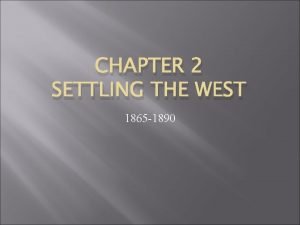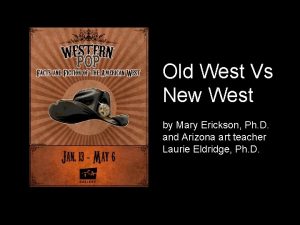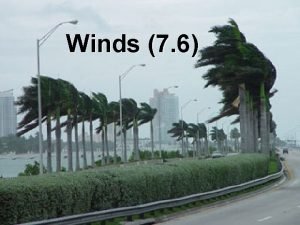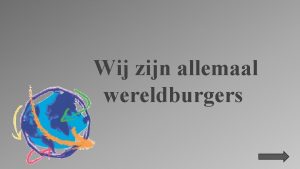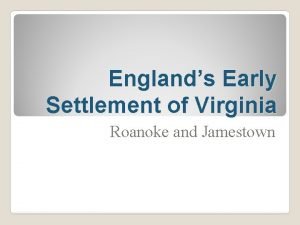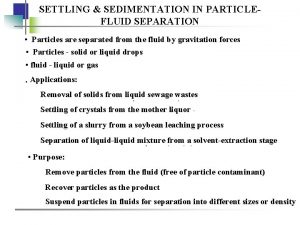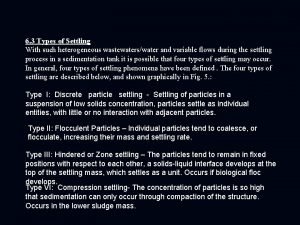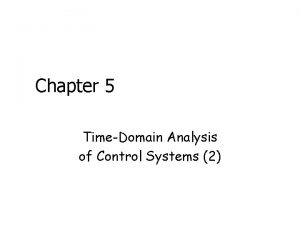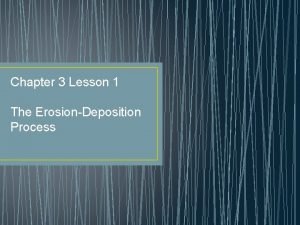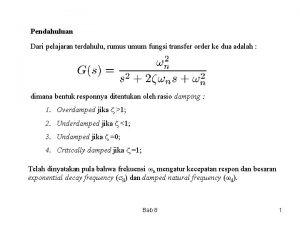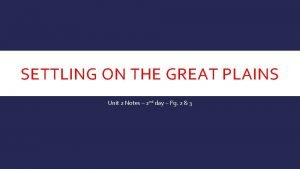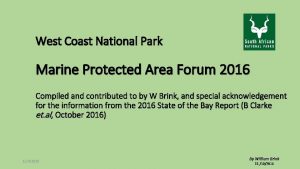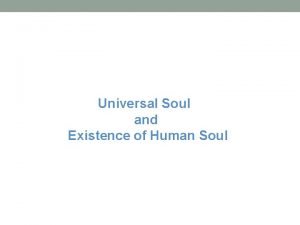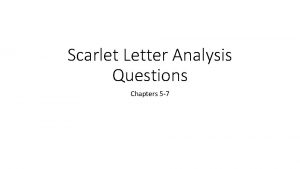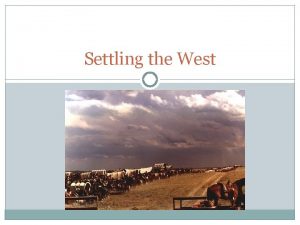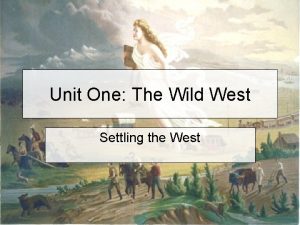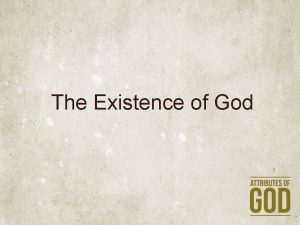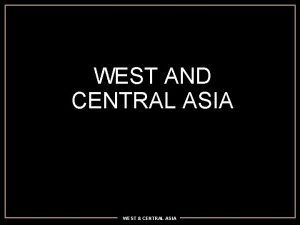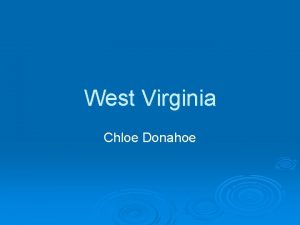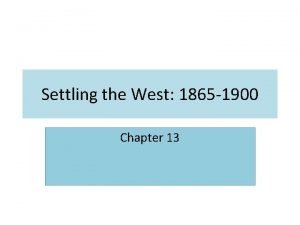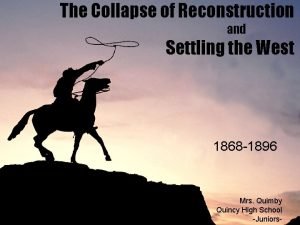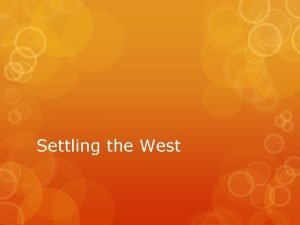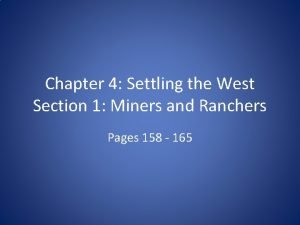Settling the West The existence of an area




































- Slides: 36

Settling the West "The existence of an area of free land, its continuous recession, and the advance of American settlement westward explain American development. “ Frederick Jackson Turner https: //www. youtube. com/watch? v=Q 16 OZkg. SXf. M

Manifest Destiny: Widely held 19 thcentury belief that the expansion of the U. S. throughout North America was both justified and inevitable

The Big Idea & Relevance • The Big Idea: As more settlers moved West, mining, ranching, and railroads soon transformed the western landscape and the United States • Developments of this period are still evident today: • Native American reservations still exist • The myth of the Western hero is still prominent in culture • New technologies in farming and mining


The Oregon Trail • The trail was a 2, 170 mile route from Missouri to Oregon and California • The first overland small band of 70 pioneer travelers left Independence, Missouri to head West to a new frontier • From roughly 1830 to 1860, some 300, 000 Americans traveled the overland trails • It took six to seven months to travel the complete length of the trail • http: //www. smithsonianmag. com/travel/follow-relics-oregon-trail-180960589/#9 ZQKJr 0 Oj. YK 8 ru. K 0. 03



The Oregon Trail • Ideally, those making this journey departed in May to arrive before November and the first heavy snowfalls • Hardships and dangers proved numerous and discouraging. • Accidents, such as: drowning, ax wounds, shootings, or being run over by wagons or trampled by livestock, claimed many victims • Sickness, especially cholera from poor drinking water, weakened many travelers, killing some

The pioneers traveled in wagon trains, in groups ranging from ten to one hundred wagons

The Donner Party • In the spring of 1846, a group of nearly 90 emigrants left Springfield, Illinois and headed west • Only 45 of the original 89 emigrants reached California the following year • http: //www. history. com/topics/donner-party

Mining boom brings growth to the West • Settlers built homes, ranches, and farms in the new frontier • Railroads expanded west to bring western goods to eastern markets • Mining companies shipped gold and silver east from western mines


Growth of the Mining Industry • California Gold Rush - The gold rush began when gold was discovered in the Sacramento Valley in California in 1848 https: //www. youtube. com/watch? v=g. Dkqvqqj. MAA • Thousands of prospective gold miners traveled by sea or over land to San Francisco and the surrounding area in hopes of mining the precious gold • By 1849 – the population of the California territory had gone from less 1, 000 people to an estimated 100, 000 population


Miners Tools • Early prospectors would extract the shallow surface deposits of minerals by hand in a process called placer mining , using simple equipment like picks, shovels, and pans

Miners Tools • After the surface deposits dwindled, miners used quartz mining – the method of extracting minerals involving digging beneath the surface • Mining was dangerous-- equipment was unsafe and miners had to breathe hot, stuffy air that causes lung disease • Poorly planned explosions and cave-ins killed and injured many miners

Comstock Lode • In 1859 a man named Henry Comstock claimed land near Virginia City, Nevada and a huge silver deposit was discovered on the land • The discovery caused considerable excitement, the greatest since the California Gold Rush • The town transformed into a “boomtown” of about 30, 000 people, and mining camps in the area grew into bustling centers of fabulous wealth based on silver and gold ore.

Boom to Bust • These “boomtowns” would pop up at astounding rates, building opera houses, shops, newspaper headquarters, and hotels • However, when the towns mines were exhausted and there were no more minerals to be mined, these “boomtowns” turned into “ghost towns” • This cycle of boom and bust- from boomtown to ghost town- was repeated throughout the mountainous West


Vigilance Committees • During the booms, crime posed a serious problem • Prospectors fought over claims and thieves haunted the streets and trails • Law enforcers were few and self-appointed volunteers formed vigilance committees to keep the law

Colorado Mining • One of the richest strikes was in Leadville, Colorado in the late 1870 s • By the summer of 1879 as many as 1, 000 newcomers a week were coming into Leadville • Mining generated more than $1 billion worth of silver and gold in Colorado alone • This spurred the building of railroads through the Rocky Mountains and transformed Denver into the city it would become today


Ranching and Cattle Drives • Cattle ranching had been introduced to the Southwestern U. S. by Mexico prior to that area becoming part of the U. S. • Increased demand for beef helped the cattle industry grow, aided by shortages in the East (Civil War) and railroads coming out West. • This demand for beef created a short-lived Cattle Kingdom that stretched from Texas to Canada

Texas Longhorn • In the early 1800 s Americans did not think cattle ranches on the Great Plains were practical • Water was scarce and the cattle from the East could not survive • However, the Texas longhorn was a hardy breed of Spanish cattle decent that lived in Mexico and Texas • By 1865, nearly 5 million longhorns roamed Texas

Cowboys (1866 -1886) • Cowboys were workers who took care of ranchers’cattle. • They borrowed many techniques from vaqueros (Mexican ranch hands) • Cattle ranchers in Texas drove herds to railroad towns like Abilene, Kansas to be shipped east ($5 in Texas; $60 in Chicago) in what was called the long drive. – The Chisholm Trail was a popular route for cattle drives. – Set up by Joseph Mc. Coy in 1867; 1500 miles – Could travel an average of 15 miles a day • Life in cattle towns was often rough and violent.


Cowboys Wore wide brim hat to protect from sun Bandanas were used to keep dust out of face Chaps were used to protect from briars and cactus Not a particularly skilled marksmen Nearly ¼ were African American and some were partially Mexican Smaller than average to make it easier on horses https: //www. youtube. com/watch? v=fn. OX 45 S 8 Ul 8

-Ranchers grazed huge herds on public land called the open range. -Competition, the invention of barbed wire by Joseph Glidden (created private property and “range wars”), and the loss of prairie grass (overuse and blizzards of 1866 -1867) brought an end to the Cattle Kingdom

Communications & Travel The growth of the West created a need for communication across the country. ◦ The Pony Express carried messages on a route 2, 000 miles long. ◦ Telegraph lines put the Pony Express out of business. http: //www. bing. com/videos/search? q=pony+express+video&view=detail&mid=E 7 DA 07 DFEEAC 5 E 127 C 8 A&FORM=VIRE&adlt=strict

Communications & Travel Demand for a transcontinental railroad grew. ◦ Congress passed the Pacific Railway Acts of 1862 and 1864, giving railroad companies loans and land grants. ◦ In return, the railroads agreed to carry mail and troops at a lower cost. Before the Transcontinental Railroad, it took almost six months and cost $1000 to travel between California and New York. After the railroad was completed in 1869, it cost $150 and took one week. For the first time, U. S. Americans could freely travel from coast to coast.




Frederick Jackson Turner The Frontier Thesis, or Turner Thesis, argued in 1893 that American democracy was formed by the American frontier. Every generation moved further west and became less connected to “Old Country” traditions and institutions, and more “American, ” more democratic, and more intolerant of hierarchy. When the U. S. Census of 1890 officially stated that the American frontier had broken up, Turner sounded an alarm, speculating as to what this meant for society since the source of America's innovation and democratic ideals was disappearing. Are there still “frontiers” for Americans to conquer today?

The West in Popular Culture

Wild West Shows & Dime Novels Buffalo Bill Wild West Show Video https: //www. youtube. com/watch? v=UJ 7 DZD-z. ATw
 Guided reading activity settling the west 1865-1890 answers
Guided reading activity settling the west 1865-1890 answers Settling the west part 2 packet- farming the plains
Settling the west part 2 packet- farming the plains West north west wind direction
West north west wind direction Old west vs new west
Old west vs new west Name of the wind series
Name of the wind series Kaart noord-oost-west-zuid
Kaart noord-oost-west-zuid East is east and west is west
East is east and west is west Wesam al madhoun
Wesam al madhoun Settling jamestown
Settling jamestown Solid spherical particles of coffee extract from a dryer
Solid spherical particles of coffee extract from a dryer Settling types
Settling types Esp electrodes
Esp electrodes Floating and settling
Floating and settling Dominant poles
Dominant poles Terminal velocity
Terminal velocity Differential settling method
Differential settling method Settling velocity
Settling velocity Peak time
Peak time Primary detention
Primary detention Primary settling
Primary settling Chapter 4 settling disputes
Chapter 4 settling disputes Laying down or settling of eroded material
Laying down or settling of eroded material Floating and settling definition
Floating and settling definition 4lovo
4lovo Settling time control system
Settling time control system Hazen formula for settling velocity
Hazen formula for settling velocity Yshss
Yshss Late charges in front office
Late charges in front office Gravitational settling chamber
Gravitational settling chamber Rumus settling time
Rumus settling time Settling on the great plains section 2
Settling on the great plains section 2 West coast national park marine protected area
West coast national park marine protected area The universal soul has been referred to as
The universal soul has been referred to as Existence and uniqueness of square roots and cube roots
Existence and uniqueness of square roots and cube roots Disembodied existence definition
Disembodied existence definition The scarlet letter chapter 5 summary
The scarlet letter chapter 5 summary Moral argument for god's existence
Moral argument for god's existence
